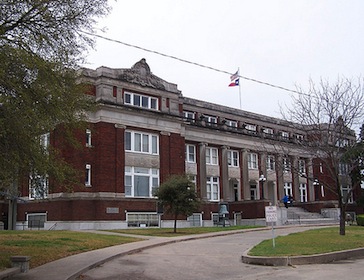GROESBECK – On her way to work recently, Jackie Levingston, the volunteer mayor of this ranching town east of Waco, stopped at an office in City Hall to pay her water bill. “Before there’s no water left to buy,” she said, making a sad joke.
Groesbeck, which has received no measurable rainfall since April, ranks near the top of the state’s list of communities in danger of running out of water. The most intense drought in Texas history has caused the water against the dam dividing the Navasota River, Groesbeck’s sole source of water, to fall 44 inches below its normal level.
Local leaders are attempting a quick fix, lest the town — whose population is 4,328 plus a 1,000-bed federal prison — run out of water by Thanksgiving, something Levingston recently warned was possible. The local paper, The Groesbeck Journal, ends virtually every water-related article with the admonition “Continue to pray for rain!”
Other cities in Limestone County do not face as dire a situation as Groesbeck, the county seat, because they rely on different sources of water, like groundwater wells. But 18 communities across Texas, including the Austin suburbs Leander and Cedar Park as well as Groesbeck, are on the Texas Commission on Environmental Quality’s “high priority” water list, which covers cities and towns that may either run out of water within 180 days if nothing changes (like rainfall or a new pipeline connection) or do not know how much water they have remaining.
In Groesbeck, some residents are grumbling that town leaders could be managing better. “If we’re running out of water, how come the carwashes are still running?” said Mary Johnson of Mary’s Breakfast and Burger Barn, a breakfast and lunch spot known for its buttermilk pie.
Groesbeck put watering restrictions in effect in August and banned all outdoor watering, starting in September. Local officials said the water had evaporated more quickly than expected in the summer heat.
A solution of sorts to keep the taps running may be at hand, although it is not guaranteed and it could be expensive. On Oct. 27, Groesbeck signed an agreement with Lehigh Hanson Inc., a construction materials company that the city has had legal disputes with over other issues in the past, to buy water from the company’s quarry. The quarry was a favorite summertime hangout of teenagers, but city officials recently removed a diving board and erected barriers around the site to discourage their return. It is full of still, clear water that has already been tested for quality, said Martha Stanton, Groesbeck’s city administrator.
The plan is for the quarry water, which Groesbeck began pumping on Wednesday, to flow three miles down nearly dry riverbeds to Fort Parker Lake, which is also dry and near the water treatment plant. But whether this will work is unknown. Earlier this month, as she gazed at the lake’s unsightly lake bed, cracked and oozing, Stanton said to Keith Tilley, her son and Groesbeck’s public works director: “I didn’t know it was this bad. I don’t know if our plan is going to work.”
If the dry riverbeds absorb the water, the town, with its per-capita income of just more than $10,500, may need to build a far more expensive pipeline to the quarry.
For the residents, the stakes are high. Levingston fought back tears as she testified about Groesbeck’s plight to state lawmakers in Austin two weeks ago.
“Gentlemen,” she told them, “there will never be anybody coming to Groesbeck if there is no water. And the people that are there are not going to stay.”
– Susannah Jacob, The Texas Tribune
This article originally appeared in The Texas Tribune at http://trib.it/tqgaiw.

